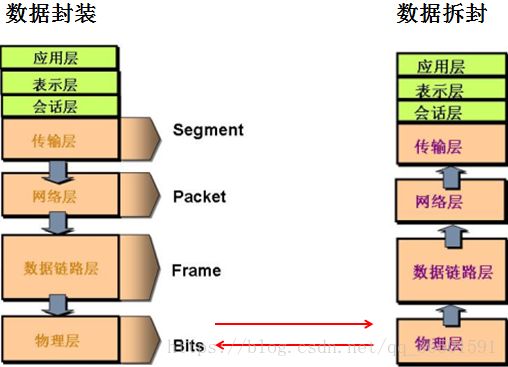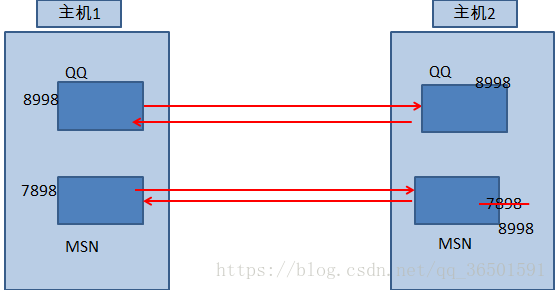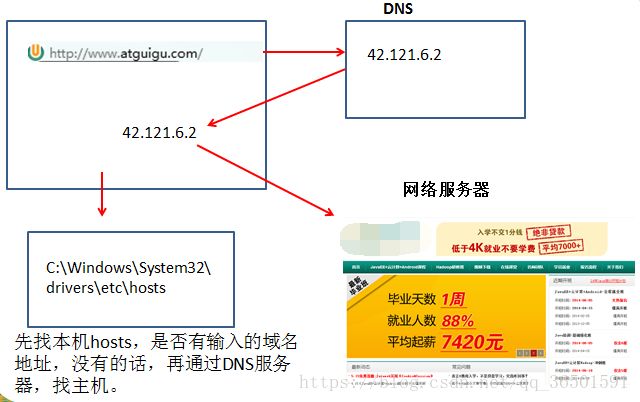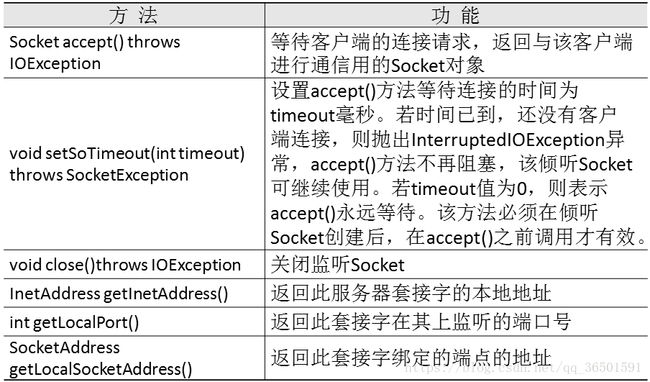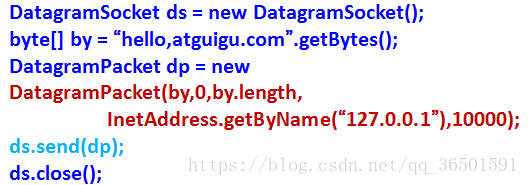java基础学习总结(十)——网络编程二
第14章:网络编程(day20)
day20
day20_03网络通信概述
主要内容
- 网络编程概述
- 通讯要素
- IP和端口号
- 网络通信协议
- InetAddress类
- TCP网络通信
- UDP网络通信
- URL编程
网络编程概述
- Java是 Internet 上的语言,它从语言级上提供了对网络应用程序的支持,程序员能够很容易开发常见的网络应用程序。
- Java提供的网络类库,可以实现无痛的网络连接,联网的底层细节被隐藏在 Java 的本机安装系统里,由 JVM 进行控制。并且 Java 实现了一个跨平台的网络库,程序员面对的是一个统一的网络编程环境。
网络基础
- 计算机网络:
把分布在不同地理区域的计算机与专门的外部设备用通信线路互连成一个规模大、功能强的网络系统,从而使众多的计算机可以方便地互相传递信息、共享硬件、软件、数据信息等资源。
- 网络编程的目的:
直接或间接地通过网络协议与其它计算机进行通讯。
- 网络编程中有两个主要的问题:
- 如何准确地定位网络上一台或多台主机
- 找到主机后如何可靠高效地进行数据传输。
- 如何实现网络中的主机互相通信:
- 通信双方地址
- 一定的规则(有两套参考模型)
- OSI参考模型:模型过于理想化,未能在因特网上进行广泛推广
- TCP/IP参考模型(或TCP/IP协议):事实上的国际标准。
网络通信协议
通讯要素1:IP 和 端口号
- IP 地址:InetAddress
- 唯一的标识 Internet 上的计算机
- 本地回环地址(hostAddress):127.0.0.1 主机名(hostName):localhost
- 不易记忆
- 端口号标识正在计算机上运行的进程(程序)
- 不同的进程有不同的端口号
- 被规定为一个 16 位的整数 0~65535。其中,0~1023被预先定义的服务通信占用(如MySql占用端口3306,http占用端口80等)。除非我们需要访问这些特定服务,否则,就应该使用 1024~65535 这些端口中的某一个进行通信,以免发生端口冲突。
- 端口号与IP地址的组合得出一个网络套接字。
day20_04InetAddress类的创建和使用
InetAddress类
- Internet上的主机有两种方式表示地址:
- 域名(hostName):www.atguigu.com
- IP 地址(hostAddress):202.108.35.210
- InetAddress类主要表示IP地址,两个子类:Inet4Address、Inet6Address。
- InetAddress 类对象含有一个 Internet 主机地址的域名和IP地址:www.atguigu.com 和 202.108.35.210。
- 域名容易记忆,当在连接网络时输入一个主机的域名后,域名服务器(DNS)负责将域名转化成IP地址,这样才能和主机建立连接。 -------域名解析
访问域名流程图
- InetAddress类没有提供公共的构造器,而是提供了如下两个静态方法来获取InetAddress实例
- InetAddress提供了如下几个常用的方法
代码示例一:
网络通信的第一个要素:IP地址。通过IP地址,唯一的定位互联网上一台主机
InetAddress:位于java.net包下
1.InetAddress用来代表IP地址。一个InetAdress的对象就代表着一个IP地址
2.如何创建InetAddress的对象:getByName(String host)
3.getHostName(): 获取IP地址对应的域名
getHostAddress():获取IP地址
public class TestInetAddress {
public static void main(String[] args) throws Exception {
//创建一个InetAddress对象,getByName()
InetAddress inet = InetAddress.getByName("www.atguigu.com");
System.out.println(inet);//域名/ip地址:www.atguigu.com/42.121.6.2
//getHostName:获取域名.getHostAddress:获取ip地址.
System.out.println(inet.getHostName());//www.atguigu.com
System.out.println(inet.getHostAddress());//42.121.6.2
//获取本机的ip:getLocalHost()
InetAddress inet1 = InetAddress.getLocalHost();
System.out.println(inet1);//GORDENWEN-PC/192.168.0.101
System.out.println(inet1.getHostName());//GORDENWEN-PC
System.out.println(inet1.getHostAddress());//192.168.0.101
}
}
day20_05网络通信协议TCP_UDP
通讯要素2:网络通信协议
- 网络通信协议
计算机网络中实现通信必须有一些约定,即通信协议,对速率、传输代码、代码结构、传输控制步骤、出错控制等制定标准。
- 通信协议分层的思想
由于结点之间联系很复杂,在制定协议时,把复杂成份分解成一些简单的成份,再将它们复合起来。最常用的复合方式是层次方式,即同层间可以通信、上一层可以调用下一层,而与再下一层不发生关系。各层互不影响,利于系统的开发和扩展。
TCP/IP协议簇
- 传输层协议中有两个非常重要的协议:
- 传输控制协议TCP(Transmission Control Protocol)
- 用户数据报协议UDP(User Datagram Protocol)。
- TCP/IP 以其两个主要协议:传输控制协议(TCP)和网络互联协议(IP)而得名,实际上是一组协议,包括多个具有不同功能且互为关联的协议。
- IP(Internet Protocol)协议是网络层的主要协议,支持网间互连的数据通信。
- TCP/IP协议模型从更实用的角度出发,形成了高效的四层体系结构,即物理链路层、IP层、传输层和应用层。
TCP 和 UDP
- TCP协议:
- 使用TCP协议前,须先建立TCP连接,形成传输数据通道
- 传输前,采用“三次握手”方式,是可靠的
- TCP协议进行通信的两个应用进程:客户端、服务端
- 在连接中可进行大数据量的传输
- 传输完毕,需释放已建立的连接,效率低
- UDP协议:
- 将数据、源、目的封装成数据包,不需要建立连接
- 每个数据报的大小限制在64K内
- 因无需连接,故是不可靠的
- 发送数据结束时无需释放资源,速度快
day20_06基于TCP_IP协议的网络编程例1_例2
Socket
- 利用套接字(Socket)开发网络应用程序早已被广泛的采用,以至于成为事实上的标准。
- 通信的两端都要有Socket,是两台机器间通信的端点
- 网络通信其实就是Socket间的通信。
- Socket允许程序把网络连接当成一个流,数据在两个Socket间通过IO传输。
- 一般主动发起通信的应用程序属客户端,等待通信请求的为服务端
基于Socket的TCP编程
- Java语言的基于套接字编程分为服务端编程和客户端编程,其通信模型如图所示:
基于TCP的Socket通信
Socket类的常用方法
| 方法 |
功能 |
| InetAddress getLocalAddress() |
返回对方Socket中的IP的InetAddress对象 |
| int getLocalPort() |
返回本地Socket中的端口号 |
| InetAddress getInetAddress() |
返回对方Socket中IP地址 |
| int getPort() |
返回对方Socket中的端口号 |
| void close() throws IOException |
关闭Socket,不可在以后的网络连接中使用,除非创建新的套接字 |
| InputStream getInputStream() throws IOException |
获取与Socket相关联的字节输入流,用于从Socket中读数据。 |
| OutputStream getOutputStream() throws IOException |
获取与Socket相关联的字节输出流,用于向Socket中写数据。 |
基于Socket的TCP编程
- 客户端Socket的工作过程包含以下四个基本的步骤:
- 创建 Socket:根据指定服务端的 IP 地址或端口号构造 Socket 类对象。若服务器端响应,则建立客户端到服务器的通信线路。若连接失败,会出现异常。
- 打开连接到 Socket 的输入/出流: 使用 getInputStream()方法获得输入流,使用 getOutputStream()方法获得输出流,进行数据传输
- 按照一定的协议对 Socket 进行读/写操作:通过输入流读取服务器放入线路的信息(但不能读取自己放入线路的信息),通过输出流将信息写入线程。
- 关闭 Socket:断开客户端到服务器的连接,释放线路
客户端创建Socket对象
- 客户端程序可以使用Socket类创建对象,创建的同时会自动向服务器方发起连接。Socket的构造方法是:
- Socket(String host,int port)throws UnknownHostException,IOException:向服务器(域名是host。端口号为port)发起TCP连接,若成功,则创建Socket对象,否则抛出异常。
- Socket(InetAddress address,int port)throws IOException:根据InetAddress对象所表示的IP地址以及端口号port发起连接。
- 客户端建立socketAtClient对象的过程就是向服务器发出套接字连接请求
Socket s = new Socket(“192.168.40.165”,9999);
OutputStream out = s.getOutputStream();
out.write(“hello”.getBytes());
s.close();
- 服务器程序的工作过程包含以下四个基本的步骤:
- 调用 ServerSocket(int port) :创建一个服务器端套接字,并绑定到指定端口上。用于监听客户端的请求。
- 调用 accept():监听连接请求,如果客户端请求连接,则接受连接,返回通信套接字对象。
- 调用 该Socket类对象的 getOutputStream() 和 getInputStream ():获取输出流和输入流,开始网络数据的发送和接收。
- 关闭ServerSocket和Socket对象:客户端访问结束,关闭通信套接字。
服务器建立 ServerSocket 对象
- ServerSocket 对象负责等待客户端请求建立套接字连接,类似邮局某个窗口中的业务员。也就是说,服务器必须事先建立一个等待客户请求建立套接字连接的ServerSocket对象。
- 所谓“接收”客户的套接字请求,就是accept()方法会返回一个 Socket 对象
ServerSocket ss = new ServerSocket(9999);
Socket s = ss.accept ();
InputStream in = s.getInputStream();
byte[] buf = new byte[1024];
int num = in.read(buf);
String str = new String(buf,0,num);
System.out.println(s.getInetAddress().toString()+”:”+str);
s.close();
ss.close();
范例一:
//TCP编程例一:客户端给服务端发送信息。服务端输出此信息到控制台上
//网络编程实际上就是Socket的编程
public class TestTCP1 {
// 客户端
@Test
public void client(){
Socket socket = null;
OutputStream os = null;
try {
//1.创建一个Socket的对象,通过构造器指明服务端的IP地址,以及其接收程序的端口号
socket = new Socket("127.0.0.1", 9090);
//2.getOutputStream():发送数据,方法返回OutputStream的对象
os = socket.getOutputStream();
//3.具体的输出过程
os.write("我是客户端,请多关照".getBytes());
}catch (IOException e) {
e.printStackTrace();
}finally {
if(os != null){
try {
os.close();
} catch (IOException e) {
e.printStackTrace();
}
}
if(socket != null){
try {
socket.close();
} catch (IOException e) {
e.printStackTrace();
}
}
}
}
//服务端
@Test
public void server(){
ServerSocket ss = null;
Socket s = null;
InputStream is = null;
try {
//1.创建一个ServerSocket的对象,通过构造器指明自身的端口号
ss = new ServerSocket(9090);
//2.调用其accept()方法,返回一个Socket的对象
s = ss.accept();
//3.调用Socket对象的getInputStream()获取一个从客户端发送过来的输入流
is = s.getInputStream();
//4.对获取的输入流进行的操作
byte[] b = new byte[20];
int len;
while((len = is.read(b)) != -1){
String str = new String(b, 0, len);
System.out.print(str);
}
System.out.println("收到来自于"+s.getInetAddress().getHostAddress()+"的连接");
} catch (IOException e) {
e.printStackTrace();
}finally {
//5.关闭相应的流以及Socket、ServerSocket的对象
if(is != null){
try {
is.close();
} catch (IOException e) {
e.printStackTrace();
}
}
if(s != null){
try {
s.close();
} catch (IOException e) {
e.printStackTrace();
}
}
if(ss != null){
try {
ss.close();
} catch (IOException e) {
e.printStackTrace();
}
}
}
}
范例二:
//TCP编程例二:客户端给服务端发送信息,服务端将信息打印到控制台上,同时发送“已收到信息”给客户端
public class TestTCP2 {
//客户端
@Test
public void client(){
Socket socket = null;
OutputStream os = null;
InputStream is = null;
try {
socket = new Socket(InetAddress.getByName("127.0.0.1"), 8989);
os = socket.getOutputStream();
os.write("我是客户端".getBytes());
//shutdownOutput():执行此方法,显式的告诉服务端发送完毕!
socket.shutdownOutput();
is = socket.getInputStream();
byte[] b = new byte[20];
int len;
while((len=is.read(b))!=-1){
String str = new String(b, 0, len);
System.out.print(str);
}
} catch (IOException e) {
e.printStackTrace();
}finally {
if(is != null){
try {
is.close();
} catch (IOException e) {
e.printStackTrace();
}
}
if(os != null){
try {
os.close();
} catch (IOException e) {
e.printStackTrace();
}
}
if(socket != null){
try {
socket.close();
} catch (IOException e) {
e.printStackTrace();
}
}
}
}
//服务端
@Test
public void server(){
ServerSocket ss = null;
Socket s = null;
InputStream is = null;
OutputStream os = null;
try {
ss = new ServerSocket(8989);
s = ss.accept();
is = s.getInputStream();
byte[] b = new byte[20];
int len;
while((len=is.read(b))!=-1){
String str = new String(b, 0, len);
System.out.print(str);
}
os = s.getOutputStream();
os.write("服务器发出去-->我已收到你的信息".getBytes());
} catch (IOException e) {
e.printStackTrace();
}finally {
if(os != null){
try {
os.close();
} catch (IOException e) {
e.printStackTrace();
}
}
if(is != null){
try {
is.close();
} catch (IOException e) {
e.printStackTrace();
}
}
if(s != null){
try {
s.close();
} catch (IOException e) {
e.printStackTrace();
}
}
if(ss != null){
try {
ss.close();
} catch (IOException e) {
e.printStackTrace();
}
}
}
}
}
day20_07基于TCP_IP协议的网络编程例3_浏览器访问Tomcat服务器端资源
范例三:
//TCP编程例三:从客户端发送文件给服务端,服务端保存到本地。并返回“发送成功”给客户端。并关闭相应的连接。
//如下的程序,处理异常时,要使用try-catch-finally!!本例仅为了书写方便~
public class TestTCP3 {
//客户端
@Test
public void client() throws Exception{
//1.创建Socket的对象
Socket socket = new Socket(InetAddress.getByName("127.0.0.1"), 9898);
//2.从本地获取一个文件发送给服务端
OutputStream os = socket.getOutputStream();
FileInputStream fis = new FileInputStream(new File("1.jpg"));
byte[] bs = new byte[1024];
int len;
while((len=fis.read(bs)) != -1){
os.write(bs, 0, len);
}
socket.shutdownOutput();
//3.接收来自于服务端的信息
InputStream is = socket.getInputStream();
byte[] bs2 = new byte[1024];
int len2;
while((len2 = is.read(bs2)) != -1){
String str = new String(bs2, 0, len2);
System.out.print(str);
}
//4.关闭相应的流和Socket对象
is.close();
fis.close();
os.close();
socket.close();
}
//服务端
@Test
public void server() throws Exception{
//1.创建一个ServerSocket的对象
ServerSocket ss = new ServerSocket(9898);
//2.调用其accept()方法,返回一个Socket的对象
Socket socket = ss.accept();
//3.将从客户端发送来的信息保存到本地
InputStream is = socket.getInputStream();
FileOutputStream fos = new FileOutputStream(new File("2.jpg"));
byte[] bs = new byte[1024];
int len;
while((len = is.read(bs))!=-1){
fos.write(bs, 0, len);
}
System.out.println("收到来自于" + socket.getInetAddress().getHostAddress() + "的文件");
//4.发送"接收成功"的信息反馈给客户端
OutputStream os = socket.getOutputStream();
os.write("你发送的图片我已接收成功!".getBytes());
//5.关闭相应的流和Socket及ServerSocket的对象
os.close();
fos.close();
is.close();
socket.close();
ss.close();
}
}
day20_08基于UDP_IP协议的网络编程
UDP网络通信
- 类 DatagramSocket 和 DatagramPacket 实现了基于 UDP 协议网络程序。
- UDP数据报通过数据报套接字 DatagramSocket 发送和接收,系统不保证UDP数据报一定能够安全送到目的地,也不能确定什么时候可以抵达。
- DatagramPacket 对象封装了UDP数据报,在数据报中包含了发送端的IP地址和端口号以及接收端的IP地址和端口号。
- UDP协议中每个数据报都给出了完整的地址信息,因此无须建立发送方和接收方的连接
- 流 程:
- DatagramSocket与DatagramPacket
- 建立发送端,接收端
- 建立数据包
- 调用Socket的发送、接收方法
- 关闭Socket
- 发送端与接收端是两个独立的运行程序
发送端
接收端
范例一:
//UDP编程的实现
public class TestUDP {
//发送端
@Test
public void send(){
DatagramSocket ds = null;
try {
ds = new DatagramSocket();
byte[] b = "你好,我是要发送的数据".getBytes();
DatagramPacket packet = new DatagramPacket(b, 0, b.length, InetAddress.getByName("127.0.0.1"), 9090);
ds.send(packet);
} catch (IOException e) {
e.printStackTrace();
}finally {
if(ds != null){
ds.close();
}
}
}
//接收端:也是通过数据报接收
@Test
public void reveive(){
DatagramSocket ds = null;
try {
ds = new DatagramSocket(9090);//直接知道端口号就行
byte[] b = new byte[1024];
DatagramPacket packet = new DatagramPacket(b, 0, b.length);
ds.receive(packet);
String str = new String(packet.getData(), 0, packet.getLength());
System.out.println(str);
}catch (IOException e) {
e.printStackTrace();
}finally {
if(ds != null){
ds.close();
}
}
}
}
day20_09基于TCP_IP协议的网络编程练习
URL编程
- URL(Uniform Resource Locator):统一资源定位符,它表示 Internet 上某一资源的地址。通过 URL 我们可以访问 Internet 上的各种网络资源,比如最常见的 www,ftp 站点。浏览器通过解析给定的 URL 可以在网络上查找相应的文件或其他资源。
- URL的基本结构由5部分组成:
- <传输协议>://<主机名>:<端口号>/<文件名>
- 例如: http://192.168.1.100:8080/helloworld/index.jsp
(未完待续)

